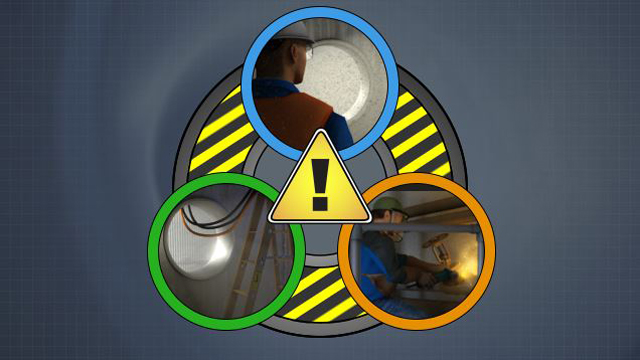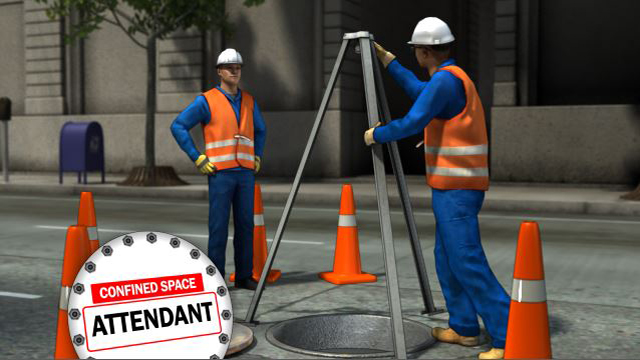




Confined Space Entry – Permit Required
A confined space is defined as a work area which has sufficient space for a person to fit within and perform work, limited means of entry and exit, and a design that was not intended for continuous worker occupancy. Working in a confined space can present hazardous atmospheres and physical dangers to employees. There are two types of confined spaces: Non-permit Required Confined Spaces and Permit-required Confined Spaces. This course will describe the dangers, best practices, and permit requirements necessary when working in a permit-required confined space.
Request a demoCourse Details
Learning Objectives
By the end of this course, you will be able to:
- Describe a permit-required confined space
- Describe the required content of a confined space permit
- Identify specific hazards that may exist within a confined space
- Identify procedures used to minimize the risk of exposure to confined space hazards [and]
- Describe the job roles and responsibilities involved in confined space entry
Specs
| Course Level | Intermediate |
| Languages | English, Arabic, Portuguese, Chinese, Dutch, French, German, Italian, Japanese, Korean, Macedonian, Tamil, Polish, Russian, Spanish, Thai, Czech |
| Compatibility | Audio, Video, MobileReady, Responsive |
| Based on: | 29 CFR 1910.146: Permit-Required Confined Spaces |
Key Questions
What is a confined space?
A hazardous confined space is defined as a work area which has all of the following characteristics: sufficient space for a person to fit within and perform work, limited means of entry and exit, and a design that was not intended for continuous worker occupancy.
What are examples of confined spaces?
Some spaces are clearly “confined,” such as storage tanks, digesters, reactors, or large process pipes which can be opened for access during a shutdown. Confined spaces may also include common areas such as pipe trenches, pits, or rooms where normal exits may be blocked by construction work.
What are the hazards of working in a confined space?
Working in a confined space can represent a “triple threat” of hazards to employees. First, workers run the risk of exposure to a range of hazardous atmospheres when entering a confined space. Second, the space can present physical dangers due to cramped working space, proximity to moving equipment, poor walking surfaces, and the possibility of engulfment. Finally, the nature of confined spaces makes rescue of someone needing assistance within the space much more difficult.
What is a permit-required confined space?
In addition to matching all the characteristics of a confined-space, a permit-requried confined space contains or has a potential to contain a hazardous atmosphere, contains a material that has the potential for engulfing an entrant, has an internal configuration such that an entrant could be trapped or asphyxiated by inwardly converging walls or by a floor which slopes downward and tapers to a smaller cross-section, or contains any other recognized serious safety or health hazard.
What types of hazards do confined spaces present?
Hazards associated with confined spaces include hazardous atmospheres, physical hazards, and entrance/exit hazads.
What are the different roles on a confined space entry team?
Every confined space entry requires a designated confined space entry team. This team must include an attendant, an entrant, an entry supervisor, and rescue and emergency services.
Sample Video Transcript
Exposure to harmful substances or environments is a leading cause of illness and death in the industrial workplace. Working in a confined space can represent a triple threat of hazards to employees. First, workers run the risk of exposure to a range of hazardous atmospheres when entering a confined space. Second, the space can present physical dangers due to cramped working space, proximity to moving equipment, poor walking surfaces, and the possibility of engulfment. Finally, the nature of confined spaces makes rescue of someone needing assistance within the space much more difficult. To be sure that work within a confined space is performed safely, employers must develop a program that help workers recognize and avoid these potentially dangerous conditions. Effective confined space entry programs should begin with the education and training of all entrants, attendants, and support personnel.
Additional Resources
- U.S. Department of Labor’s Occupational Safety & Health Administration (OSHA) – www.osha.gov
- OSHA Safety & Health Training Topics – http://www.osha.gov/SLTC/confinedspaces/
- OSHA Training Institute – www.osha.gov/dte/oti/index.html
- OSHA Safety and Health Library – www.osha.gov/dte/library/
- OSHA Confined Space document – http://www.osha.gov/dte/grant_materials/fy09/sh-18796-09/confinedspace.pdf
- The American Society of Safety Engineers – www.asse.org
Course Applies To
Demos + Pricing
Learn more about our courses, get pricing, and see our platform.











